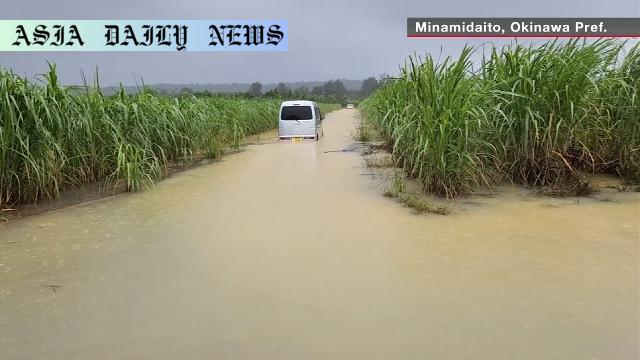Storms are bringing record-breaking rainfall and powerful winds to Japan, causing severe weather conditions in affected regions.
Two severe storms are impacting Japan, affecting Okinawa, Amami, and Ogasawara regions.
Tropical storm Co-may brings record rainfall and gusty winds in Okinawa and Amami.
Typhoon Krosa poses severe threats to the Ogasawara Islands with powerful winds and heavy rain.
Warnings for high waves, lightning strikes, and unstable weather are issued.

Tropical Storm Co-may: A Threat to Okinawa and Amami Regions
Japan faces the wrath of two storms that have disrupted regular life and triggered weather warnings in multiple areas. The first, tropical storm Co-may, is advancing towards Okinawa’s main island, having regained strength on Sunday night. With sustained wind speeds reaching 72 kilometers per hour, gusting up to 108 kilometers per hour, the storm is creating perilous conditions within 500 kilometers northeast and 165 kilometers southwest of its center. Unstable atmospheric conditions, fueled by warm, moist air and a high-pressure Pacific system, are feeding developing rain clouds over Okinawa and Amami.
Minami-Daito Island, located in Okinawa Prefecture, has endured record-breaking rainfall. Over a 72-hour period ending Monday morning, the island accumulated an astounding 527.5 millimeters of rain. This exceeds four times the average July rainfall, severely disrupting daily activities. Forecasts predict an additional 150 millimeters of rain for the Amami region and 80 millimeters for Okinawa Prefecture through Tuesday evening. The storms bring not only heavy rain but also high ocean waves and gusty, dangerous winds.
Typhoon Krosa: Heightened Danger for Ogasawara Islands
While Co-may impacts southern Japan, Typhoon Krosa looms over the Ogasawara Islands. This typhoon is advancing north with intense sustained winds of up to 90 kilometers per hour and gusts potentially reaching a dangerous 126 kilometers per hour. The islands braced for Krosa’s heavy rains, with up to 150 millimeters falling over Tuesday and another 100 millimeters expected over a subsequent 24-hour period.
The typhoon’s slow pace from Tuesday into Wednesday could sustain its impact, intensifying the threat of prolonged rainfall, severe gusts, and thunder showers. Japan’s Meteorological Agency has issued caution against lightning strikes, dangerous winds, and unstable weather patterns.
Weather Warnings Issued Across Regions
Japan’s meteorological warnings underscore the severity of these storms. The storm’s impact includes threats to safety on land and in surrounding waters, as high ocean waves and unpredictable gusts develop. Furthermore, the lingering storm conditions may exacerbate risks, urging residents and local authorities to remain vigilant and take necessary precautions.
Both Okinawa and Amami residents are urged to avoid venturing outdoors unless necessary and to prepare for extended periods of adverse conditions. As heavy rain, turbulence, and lightning continue, these regions face significant challenges before weather conditions stabilize.
Global Implications and Climate Considerations
The intense weather in Japan highlights larger climate-related issues as extreme weather patterns become more frequent globally. Rising ocean temperatures and erratic atmospheric conditions contribute to the growing intensity of tropical storms and typhoons, causing severe disruptions in regions like Japan. With these storms causing record rainfall and dangerous high winds, global conversations around climate adaptability and safety measures need continued prioritization.



Commentary
The Resilience of Japan in Facing Nature’s Fury
Japan is no stranger to harsh weather, frequently enduring intense storms as a part of its geographical reality. However, the recent combination of tropical storm Co-may and Typhoon Krosa has brought unprecedented challenges, from record-breaking rainfall to severe wind speeds. The resilience of Japan’s people and its preparedness for such extremists have always been an admirable facet of this nation.
Global Lessons From Regional Crises
As these storms hit Japan’s shores, they also signal warning signs for the rest of the world. Volatile climate conditions demand enhanced preparation and infrastructural upgrades globally. Countries observing the situation should introspect and learn from both Japan’s efficient disaster management systems and the sheer unpredictability of nature. These storms underline the importance of cohesive efforts to understand and adapt to our changing environment.
Call for Global Cooperation in Mitigating Climate Change
The sheer intensity of these storms forces us to confront the larger reality: climate change cannot be disregarded. Nations, organizations, and citizens worldwide must cooperate to mitigate the causes driving such catastrophic weather. Policies addressing ocean temperatures, deforestation, and industrial emissions are essentials in controlling the adverse impact of climate anomalies. Japan’s storms also highlight the urgent need for renewed commitments to international climate agreements.